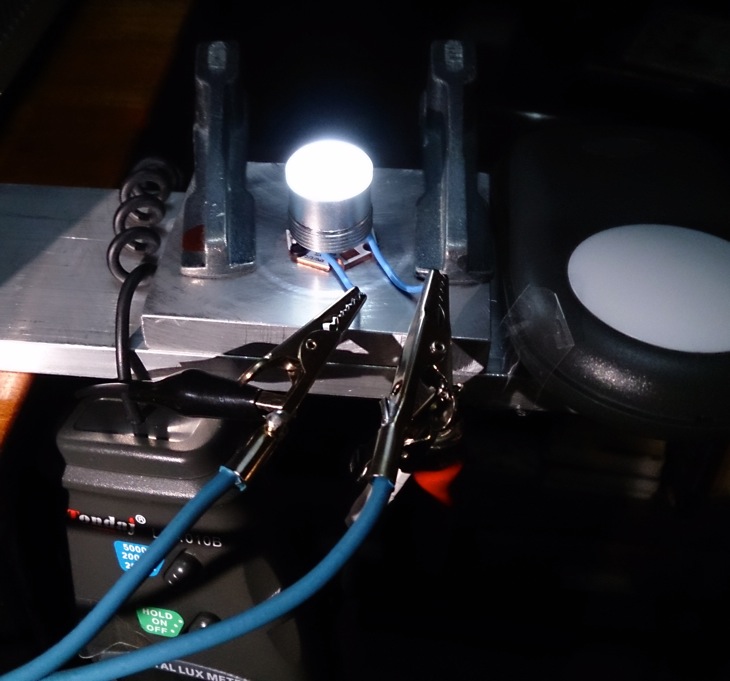I promised that I was not going to do more testing on bare leds because I do not have the equipment to guarantee accuracy of the numbers.....
Ok, one more then, because I am really curious what the limits are for copper-mounted leds (mounted well and heat-sinked well), I can not find anyone who had tested that before, and as a modder I just want to know that .
I borrowed a bench power supply from work that can deliver up to 40A and decided to sacrifice a XM-L2 and a XP-G2. I had bought those before the nice neutral bins became available and they were not going into any flashlight anyway.
When I have more time I will put the results in nice graphs, for now you will have to do with two video's and my comments on them.
EDIT: I made the graphs, with some comments, see post #51
The first video is a test on a XM-L2 T6 1C bin (I believe I bought it from cnqg), reflowed on a 20mm Sinkpad, with a 49mm reflector on top to be able to do ceiling bounce lux-measurements. The set-up is similar to the MT-G2 test and the Nichia219 test I did recently, but with a different power supply. The left reading on the power supply is the output voltage (this voltage reading appeared to be a bit wacky, in the second video I added a separate voltmeter measuring directly at the led wires), the right reading on the power supply is the current going through the circuit (and therefore, the led). Again everywhere very thick copper wiring to minimize losses between power supply and led, and lots of aluminium under the Sinkpad to maximize heat sinking. Lux was measured 76cm from the ceiling, for a lumen estimate OTF of the reflector the lux-value that can be seen in the video should be multiplied by a factor 2.06. I forgot to put a glas lens on top of the reflector, to get a OTF number that includes a non-coated glass lens substract a loss of about 5.5%.
Second is a video of a XP-G2 R5 0D bin (from Fasttech I believe), mounted on a 20mm copper Sinkpad, with a 20mm reflector and a cheap AR-coated lens on top. I took a picture of the led-situation  :
:

As mentioned I added an extra volt-reading, to avoid confusion, here is what can be seen on the video:

So here's the video:
Discussion of the video's:
The first thing I wanted to know at what current and how the leds were going to blow. The answer is somewhere between 8.5 and 10 amps. This particular xp-g2 led could even handle a bit more current than the xm-l2, but I guess it will differ a bit between individual leds. Both leds just went dark when blown up, no turning blue or flashes or anything. A close look at the fried leds show in both cases damaged silicone around the bond wires suggesting those were burnt through. The emitting surfaces look undamaged, I guess the heat sinking on Sinkpads is so good that both in the xp-g2 and the xm-l2 the bond wires are the first to go, not the die. And because (it looks like) the thickness of the bond wires of the xp-g2 and the xm-l2 is the same, the current at which they burn through is about the same. Pictures of the fried xm-l2 and the xp-g2 (same magnification):


So what else can be seen in the video's.
Well, the maximum output for the xp-g2 is reached at about 6 amps, but there is hardly anything gained anymore above 5 amps, I measure a 'OTF' number of about 880 lumen at 6 amps (I have no integrating sphere, so I can not measure bare led lumens, but these 'simulated OTF' numbers do give an idea of what can be achieved in an actual flashlight).
The output for the xm-l2 increases without topping off right up to the current at which the led is fried, so the maximum output of the die of the led is not reached when the bond wires burn through. For us 'flashlight devotees' the xm-l2 could do with some thicker bond wiring! The maximum output (for what that is worth so near to the fatal current) is about 1870 'simulated OTF' lumen (in the situation with a non-coated lens on top of the reflector). It is 1630 lumen at a 'safe' 6A. Output is of course a bit better with a quality reflector and lens.
I haven't discussed the voltage readings yet. It looks like they more or less match the numbers measured by Match, only my Vf-measurements of the xp-g2 at the higher currents are significantly higher than Match's numbers. Could it be that his Fluke was faulty already then??
That's it for now, when I have time I will put the data in some nice graphs (EDIT: done that, see post #51). Until then I hope the video's will do. Thanks for reading.


